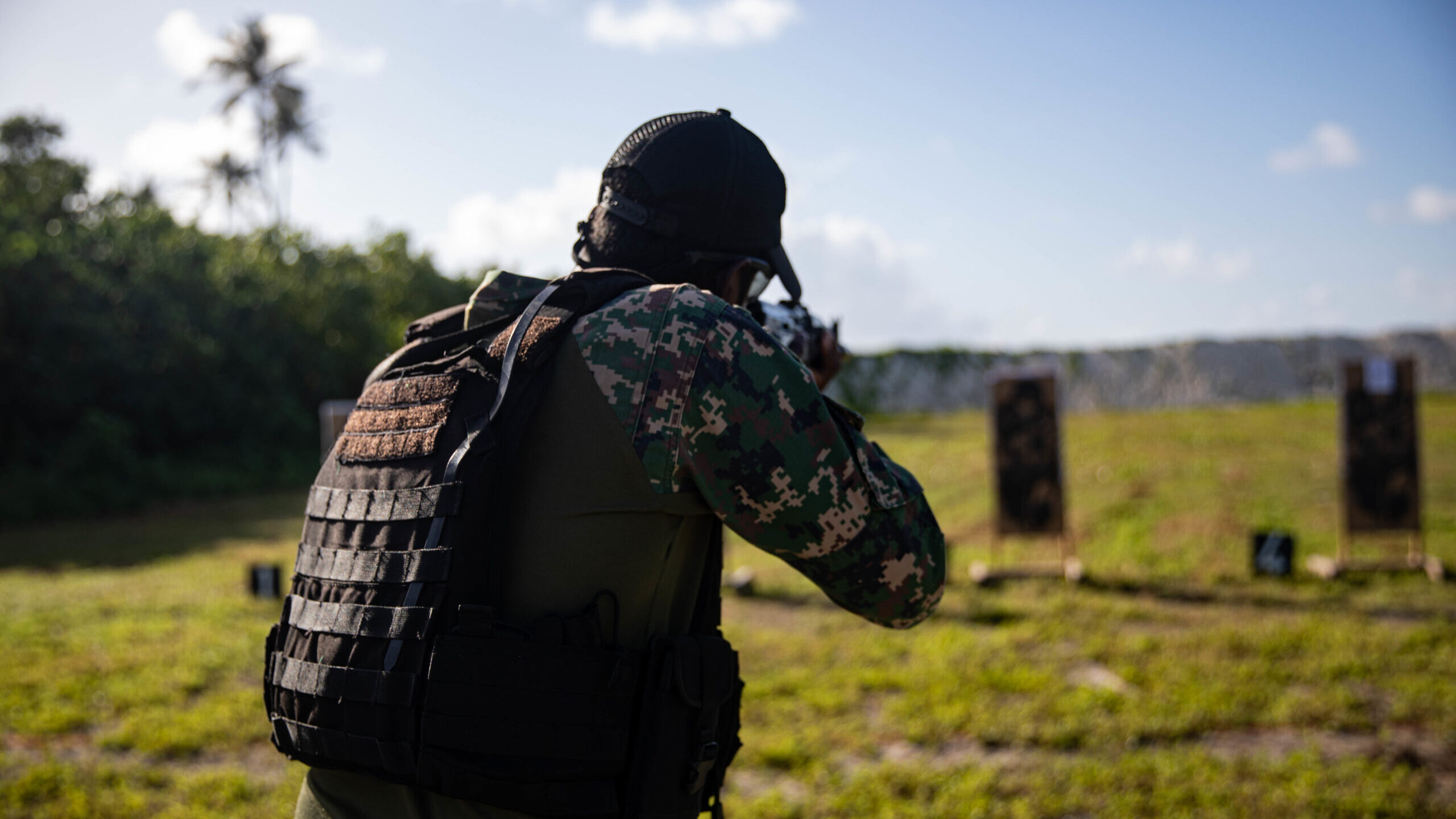
A member of the Maldives National Defense Forces conducts a live fire exercise with 5th Security Forces Assistance Brigade (SFAB) at Central Area Command, Kahdhoo, Maldives, May 22, 2022. (Spc. Jacob Núñez/US Army)
WASHINGTON — As China shows increasing aggression toward Taiwan and Russia continues its invasion of Ukraine, the US Army’s Security Force Assistance Brigades in those regions are seeing more countries request aid from the US, according to their commanders.
The Army’s Security Force Assistance Brigade effort began in 2017 to advise and train foreign militaries, an effort that strengthens the US’s relationship with foreign nations, in direct competition with China or Russia. The service now has six Security Force Assistance Brigades, each regionally focused, with the exception of the globally focused National Guard SFAB. Advisers from the SFABs train partner forces on battlefield maneuver, artillery, engineering and logistics.
“Based off of the the presence of SFAB advisers in Europe, we have seen an increase in the demand signal for our adviser teams,” said Col. Robert Born, commander of the 4th Security Force Assistant Brigade, told reporters during a media call on Thursday.
“We absolutely know that there’s other competitors within this region,” said Col. Jonathan Chung, the 5th SFAB commander said Thursday during a separate media roundtable.
Stationed at Fort Carson, Colo., the 4th SFAB began operations in Europe last October. It currently has 19 teams in 10 countries in Europe: Latvia, Poland, Bulgaria, Albania, Georgia, Slovakia, North Macedonia, Hungary, Romania and “episodic” visits to Finland, Born said.
In Europe, the SFAB is training soldiers on a variety of equipment. For example, the 4th SFAB recently trained a Romanian missile brigade on the High Mobility Artillery Rocket System platform. The Polish Army, Born said, recently asked for fires support training for one of their howitzer battalions. The North Macedonian military has requested logistics and sustainment training for Joint Light Tactical Vehicles and Stryker vehicles.
“We have a running estimate of emerging missions. We also are very focused on identifying transition criteria, so that the Allied partners that we are training with, once they have achieved the goals …. we then have the opportunity to optimize adviser teams transition to new opportunities,” Born said.
The 4th SFAB has been directly involved in helping the Ukrainians fight off the invading Russians. While the US has sent billions of dollars of weapons to Ukraine, Born said today that advisers with the 4th SFAB have been training Ukrainian soldiers in Germany, but declined to provide any examples of that training.
“4th SFAB advisers have supported training to Ukrainian Armed Forces outside of Ukraine,” Born said. “And the plan now is to continue that until we are given instructions to change mission.”
Pacific Demand
Meanwhile, the 5th Security Force Assistance Brigade out of Joint Base Lewis McChord, Wash., is focused on the Pacific, where “we continue to see the increased demand for more and more increased partnerships,” Chung told reporters.
He added that the demand is coming from across the Pacific, from Oceania to Southeast Asia to Northern parts of Asia, including Mongolia, Japan and South Korea.
In the Pacific, Chung said the SFAB’s advisers are deployed at 14 different “locations,” working with regional partners such as Indonesia. The Army is making a push in the Pacific to position itself as the partner of choice through its Pacific pathways initiative, which aims to expand US engagement with allies and partners in the Indo-Pacific.
The 5th SFABs units are across the Indo-Pacific working with foreign militaries in three different ways, Chung said. First, advisers are working with foreign rotation units, from platoons to battalions, and working with them on tactical training. Its advisers are also integrating into partners’ military institutions to help professionalize their militaries. The last effort, Chung said is “enhancing our posture” by providing equipment to partners.
“We’re trying to make sure based on the invitation of the partner or what they’re asking us to do, that we have the equipment available so we can help meet their desired needs based on what they’re asking to partner with at that training event,” Chung said.
Thailand is an example of a nation that’s asking for more help, Chung said, noting that Bangkok has taken notice of China’s activities in the Indo-Pacific and acquired Strykers through foreign military sales.
“They’ve asked for increased opportunities of touchpoints, training, logistics, partnerships to move [their] organization to really become a showcase of modernization,” Chung said.
Chung also noted that the recent flare-up of tensions between Taiwan and China, especially following US Speaker of the House Nancy Pelosi’s trip to the island nation, has not impacted how the SFAB is operating.
“The everything that has happened within the region, and then specifically … in those recent events, we’ve not changed anything in terms of our operations, activities, investments, everything is still aligned and invested to the desire and the pace of our partners,” Chung said.






















